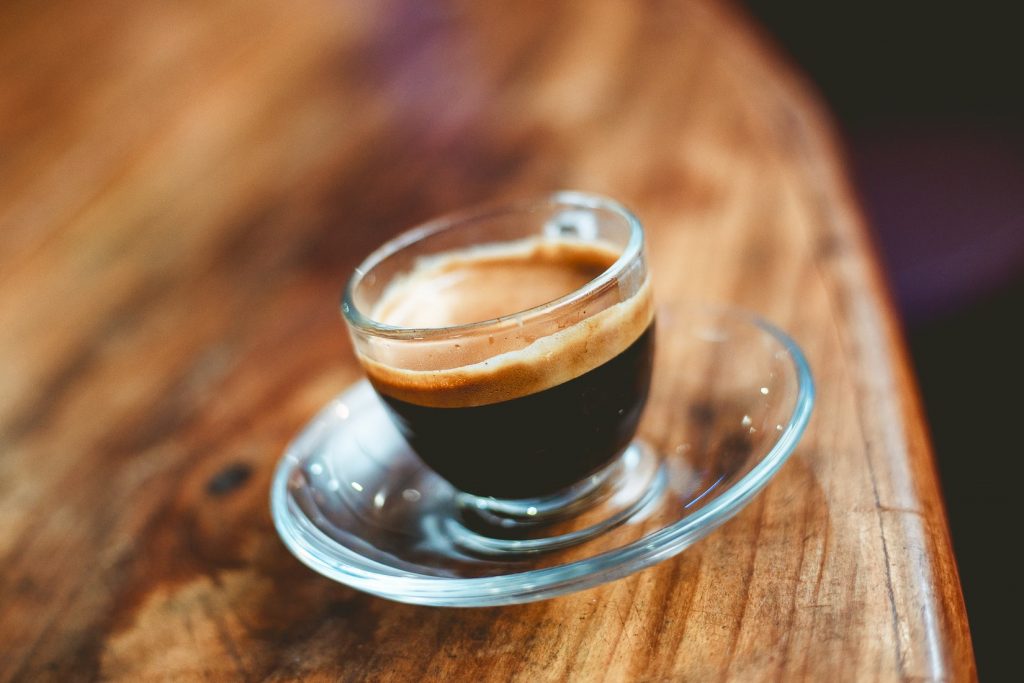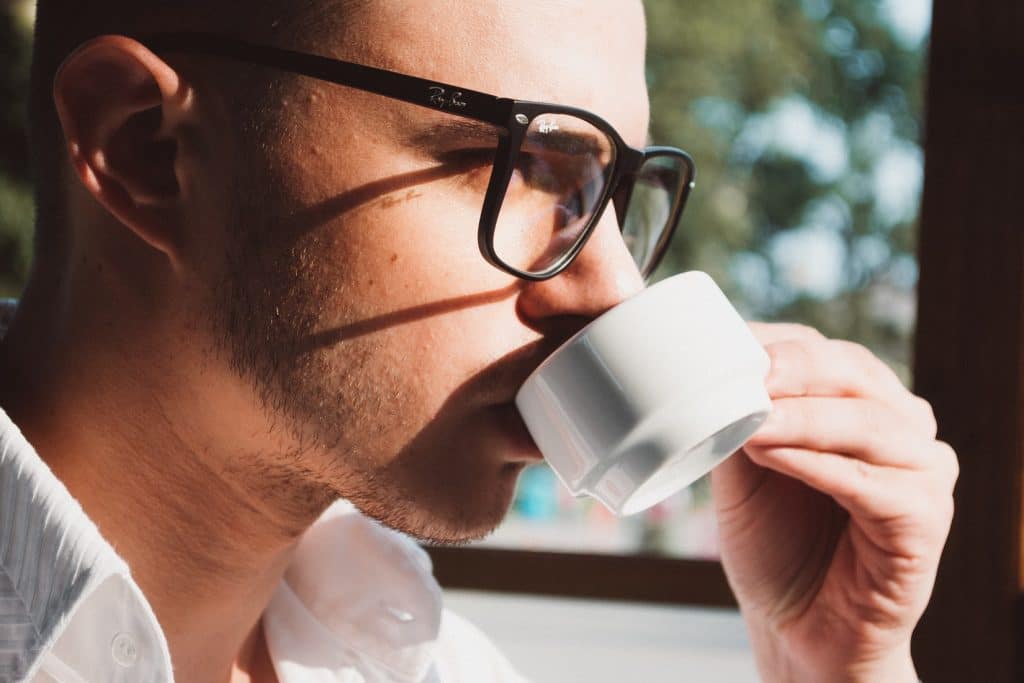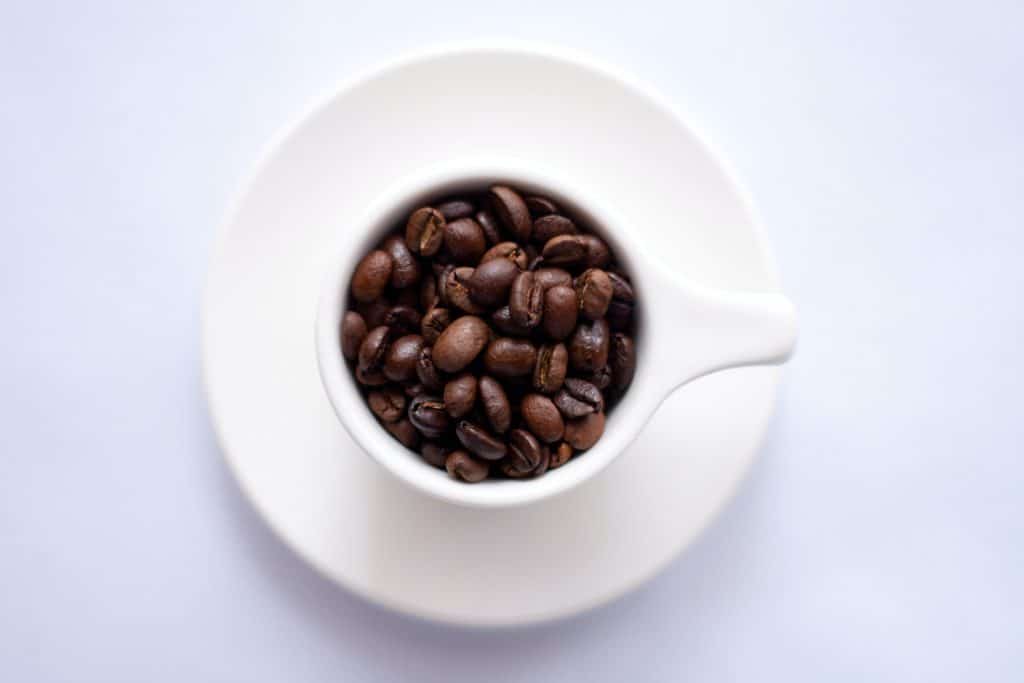Espresso is not just coffee—it’s an art. This dark drink will impress you with its intense taste, variety of aromas, and vivacity.
In order to enjoy this drink, you usually have to buy a home espresso machine or make a trip to your nearest cafe.
But if you want an espresso right now don’t want to spend much money, then keep reading—there are ways to make espresso without a coffee machine.
This article is intended primarily for those who aren’t familiar with espresso. We start with an explanation of what espresso is. If you’re already familiar with this drink, you can skip to the sections that explain how to brew espresso.
What Is Espresso?

Classic espresso is prepared in an espresso machine using technology that has not changed since the drink’s invention.
An espresso is 1.35 oz [40 ml] of black coffee. Under high pressure, almost-boiling water passes through coffee beans that have been finely ground and densely packed. Espresso is denser and more concentrated than drip coffee. On the surface of the finished drink, there is a foamy golden layer of espresso crema.
Espresso can be consumed in its pure form, but it also serves as the base of many other delicious drinks, such as cappuccinos, flat whites, and lattes. These drinks differ by how much steamed milk is added.
The Italians reflected the main components of espresso in their famous 4 M’s: miscela (using the correct coffee blend), macinazione (using the correct grind), macchina (the espresso machine), and mano (the barista).
In addition to these four elements, the taste of the drink is affected by water quality and other details. Below, we look at each of these elements in more detail, but first, let’s find out what makes such a complex espresso flavor.
How Should Espresso Taste?

Espresso has a combination of three flavors: bitterness, acidity, and sweetness.
Bitterness
Bitterness is present in any coffee, and especially in espresso, which has a very rich taste. Many people even expect bitterness in a well-roasted and well-brewed shot.
Bitterness is a crucial quality parameter for acceptance or rejection of a coffee blend.
During roasting, diketopiperazines are formed from the proteins of bitter green coffee and their content increases significantly the longer the beans are roasted. That is, the longer the beans are roasted, the more bitter your coffee will be.
Analysis of LC-ESI-MS allowed us to determine that in general, there is are 5-7 mg of diketopiperazines per 50 grams of roasted beans, and 20-30mg in espresso. The general detection threshold for bitterness for diketopiperazines is approximately 20 mg per liter of water. As a result, these substances play the role of bitter substances only in roasted coffee beans and espresso.
Acidity
When tasting coffee, acidity is also important, and this flavor is usually emphasized in espresso. Acidity is the sour flavor you recognize in fruits like lemons or green apples.
Too much acidity will make you grimace as if you were chewing a lemon slice, and too little acidity will result in a boring cup of coffee.
Sweetness
Having become accustomed to bitterness, you can forget that the ideal espresso shot needs sweet notes that balance acidity and bitterness. Keep in mind that coffee beans are the seeds of a fruit. As the fruit ripens, the coffee beans get sweeter.
During the roasting process, this sweetness is enhanced by caramelization reactions.
Which Coffee Beans Are Best for Espresso?

As a rule, blends of the best espresso coffee beans are made from different varieties of Arabica beans, though Robusta beans are also used on occasion. Arabica and Robusta beans come from separate species of coffee trees. Robusta coffee is cultivated in more areas, and is therefore much cheaper than Arabica.
Arabica has a delicate and mild flavor. Robusta is coarser, stronger, and more bitter. It has more caffeine. Robusta is added to blends for completeness of taste, sweetness, and because it gives a good crema.
As for single-origin coffee, it is not suitable for making espresso. This is due to the fact that single-origin coffee has a “one-sided” taste rather than the balance inherent in blends.
Which Grind Is Right for Espresso?
Espresso beans are ground shortly before brewing a shot. This is a very important step since both the brewing time and the taste of the drink depend on how fine or coarse the grind is. The right grind for espresso is a fine grind.
Water Quality for Espresso
Water is an important component of good espresso. Water should be clean, and filters must be used to remove chlorine and tap water impurities. Additional filtration is required if the water contains iron, sulfur, heavy metals, or other impurities.
However, water does not need to be distilled and completely free of all minerals. Water naturally contains calcium carbonate and magnesium carbonate, which determine the hardness of the water.
How to Make an Espresso Shot (Using an Espresso Machine)
As stated earlier, classic espresso can only be made using an espresso machine. Only in this way can you obtain the necessary water temperature and pressure to extract the coffee well.
Below, we explain semi-automatic and lever espresso machines.
How to make an espresso shot in a semi-automatic espresso machine
Semi-automatic machines require more human involvement than fully automatic ones. They allow you to control grind, brewing time, and other factors.
What you’ll need:
- Semi-automatic espresso machine
- Espresso beans
- Coffee grinder
- Tamper
- Cold filtered water
How to brew:
- Preheat the cup so that the drink does not cool and change taste once poured.
- Grind the beans finely.
- Place the correct amount of coffee in the portafilter.
- Tamp the grinds with the tamper.
- Remove any grinds from the rim of the portafilter.
- Attach the portafilter to the brew group.
- Place your clean, heated cup on the drip tray under the brew group.
- Brew for 25 – 30 seconds.
- Rinse the portafilter and brew head with water to remove coffee residue.
- Enjoy your espresso!
Here’s a video that will show you these steps:
How to make an espresso shot in a Lever espresso machine
The first lever espresso machine was patented in the 1930s. In classic models, the necessary pressure for preparing a drink is achieved by pressing the lever. At this point, the water enters the brew group and passes through the coffee in the portafilter.
What you’ll need:
- Lever espresso machine
- Espresso beans
- Coffee grinder
- Tamper
- Cold filtered water
- Warm mug
How to brew:
- Turn on your coffee machine and let it warm up properly.
- Finely grind the beans.
- Place the correct amount of coffee in the portafilter.
- Tamp the grinds with the tamper.
- Remove any grinds from the rim of the portafilter.
- Attach the portafilter to the brew group.
- Slowly raise the lever, and when it’s as high as it will go, wait 10 seconds and press down the lever at the same pace.
Here’s a video that will show you these steps:
How to Make Espresso Without an Espresso Machine
If you don’t have an espresso machine at home, or if you don’t have the opportunity to visit a coffee shop, then there are several alternative ways to make espresso at home.
How to make espresso in an AeroPress
The AeroPress is a device for making coffee. It was designed in 2005 by American inventor Alan Adler.
The AeroPress makes coffee by steeping coffee grounds in water and then forcing the coffee through a filter. The user forces the coffee through the filter by pressing down on a set of nested cylinders. In fact, this principle is also used in espresso machines, so with the help of an AeroPress, you can almost make a traditional espresso.
What you’ll need:
- AeroPress
- Coffee grinder
- Beans
- Paper filters
- A tamping tool
- Warm mug
How to brew:
- Rinse the AeroPress with hot water
- Finely grind 9 grams of beans
- Place a paper filter in the AeroPress
- Pour the grinds into the AeroPress
- Tamp the grinds using any tool that fits in the AeroPress
- Put a paper filter on top of the tamped coffee
- Pour in approximately 1.7 oz [50 ml] of hot water at 203 degrees Fahrenheit [95 degrees Celsius].
- Insert the piston and gradually lower it down for 30-40 seconds.
Here’s a video that will show you these steps:
How to make espresso in a Moka pot
Moka pots work via filtration. The brewing process takes place over low heat. Steam from the boiling water rises through the tube into the coffee grounds, and brewed coffee is pushed into the upper chamber of the pot.
Using a Moka pot, you can make coffee similar to espresso, but you will need to make crema.
What you’ll need:
- Moka pot
- Coffee grinder
- Coffee beans
- Cold filtered water
- Warm mug
How to brew:
- Pour warm water into the bottom chamber of the Moka pot
- Pour fine-medium grounds into the filter basket and shake to settle the grounds evenly. You will need approximately 10 grams.
- Place the filter basket in the bottom chamber.
- Screw on the upper chamber.
- Place the pot on the stove over medium heat.
- When you see the first drops of coffee, take the pot off the stove and pour a teaspoon of coffee into a mug to make the crema.
- Return the pot to the stove to continue brewing.
- As the rest of the coffee brews, add some sugar to the teaspoon of coffee in your mug. Whisk it until it becomes crema.
- Pour the rest of your coffee into your mug and let it rest for a bit before enjoying.
Here’s a video that shows you how to use a Moka pot:
How to make espresso in a French press
To make a drink similar to espresso in a French press, you will have to use less water than you do when brewing coffee.
What you’ll need:
- French press
- Coffee beans for French press (Arabica beans are suitable for this method)
- Coffee grinder
- Warm mug
How to brew:
- Heat the French press with a bit of hot water.
- Coarsely grind the coffee beans. You’ll need about 3 tbsp of grounds.
- Add the grounds to the French press.
- Pour hot water (approximately 158 to 176 degrees Fahrenheit or 70-80 degrees Celsius) into the ground coffee in a thin stream so that the water is just above the level of the coffee.
- Stir with a spoon and cover with the plunger/filter.
- Let the coffee brew for 4 minutes (or longer if you want a stronger drink).
- Slowly press the plunger down into the coffee.
Here’s a video showing the process:
How To Make Espresso With A Portable Espresso Maker
There are compact espresso makers. They are convenient to take with you on a camping trip or to the office and at the same time, they make good espresso. These handheld gadgets may vary in design, but they all work similarly.
What you’ll need:
- Portable espresso maker
- Coffee grounds
- Water
- Kettle
- Warm mug
Cooking:
- Fill the basket with 0.35 oz [10 g] of coffee grounds.
- Fill the water tank with 1-2 oz [30-40 ml] of boiling water.
- Start pumping to build up pressure.
- Stop pumping when the coffee is done extracting.
- Your travel espresso is ready!
Here’s a video that shows the process:
Sources:
- Bittere Diketopiperazine und Chlorogensäurederivate in Röstkaffee – Technische Universität Braunschweig
- Barista Technique: Dose, Distribute, Tamp. Repeat. – Home-Barista
- What Is Espresso? – The Spruce Eats
